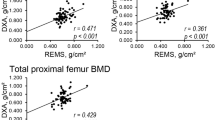Abstract
New dual-energy X-ray absorptiometry (DXA) technologies provide improved spatial resolution and high image quality. Our purpose was to review DXA examinations to detect collateral findings and to understand their potential impact on patient healthcare. We retrospectively and randomly reviewed 739 DXA examinations (191 of 739, 25.8 %, whole body; 96 of 739, 13.0 %, vertebral fracture assessment; 231 of 739, 31.3 %, lumbar spine; 221 of 739, 29.9 %, femur) that were performed in our institution with a new DXA equipment. Whenever an extra finding was discovered, the physician’s report was read and the clinical history of the patient was investigated to understand whether that finding was already known, as well as to check the diagnosis. The population included 208 male and 531 female subjects (58 ± 14 years old). Incidental findings were detected in 117 (15.8 %) of 739 DXA examinations (17 of 117, 14.5 %, whole body; 41 of 117, 35.0 %, vertebral fracture assessment; 32 of 117, 27.4 %, lumbar spine; 27 of 117, 23.1 %, femur): biliary and urinary stones (4.8 %), vascular calcifications (33.7 %), other soft tissue calcifications (25.3 %—e.g., tendons, lymph nodes, intraparenchymatous calcifications), vertebral abnormalities (14.5 %), other bone abnormalities (12.1 %), and morphovolumetric alterations or abnormal anatomical structures (9.6 %). Among all these findings, 50 (42.7 %) of 117 could be verified by other imaging modalities. Forty-nine (98.0 %) of 50 incidental findings were identified as true findings, and DXA was able to orient the diagnosis (exact diagnosis in 37 of 50, 74.0 %); however, none of them was mentioned on available DXA reports. An interpreting physician should treat the DXA image with the same attention given to any other X-ray image. Sometimes DXA may allow a qualitative diagnosis of collateral findings. However, potential negative effects on healthcare economy should be considered for false-positive or insignificant findings.








Similar content being viewed by others
References
Orme NM, Fletcher JG, Siddiki HA, Harmsen WS, O’Byrne MM, Port JD, Tremaine WJ, Pitot HC, McFarland EG, Robinson ME, Koenig BA, King BF, Wolf SM (2010) Incidental findings in imaging research: evaluating incidence, benefit, and burden. Arch Intern Med 170:1525–1532
Parker LS (2008) The future of incidental findings: Should they be viewed as benefits? J Law Med Ethics 36:341–351
Siddiki H, Fletcher JG, McFarland B, Dajani N, Orme N, Koenig B, Strobel M, Wolf SM (2008) Incidental findings in CT colonography: literature review and survey of current research practice. J Law Med Ethics 36:320–331
Colletti PM (2008) Incidental findings on cardiac imaging. Am J Roentgenol 191:882–884
Vernooij MW, Ikram MA, Tanghe HL, Vincent AJ, Hofman A, Krestin GP, Niessen WJ, Breteler MM, van der Lugt A (2007) Incidental findings on brain MRI in the general population. N Engl J Med 357:1821–1828
Green D (2005) Incidental findings computed tomography of the thorax. Semin Ultrasound CT MRI 26:14–19
Berland LL, Silverman SG, Gore RM, Mayo-Smith WW, Megibow AJ, Yee J, Brink JA, Baker ME, Federle MP, Foley WD, Francis IR, Herts BR, Israel GM, Krinsky G, Platt JF, Shuman WP, Taylor AJ (2010) Managing incidental findings on abdominal CT: white paper of the ACR incidental findings committee. J Am Coll Radiol 7:754–773
Hull H, He Q, Thornton J, Javed F, Allen L, Wang J, Pierson RN Jr, Gallagher D (2009) iDXA, Prodigy, and DPXL dual-energy X-ray absorptiometry whole-body scans: a cross-calibration study. J Clin Densitom 12:95–102
Soriano JM, Ioannidou E, Wang J, Thornton JC, Horlick MN, Gallagher D, Heymsfield SB, Pierson RN (2004) Pencil-beam vs fan-beam dual-energy X-ray absorptiometry comparisons across four systems: body composition and bone mineral. J Clin Densitom 7:281–289
Author information
Authors and Affiliations
Corresponding author
Additional information
The authors have stated that they have no conflict of interest.
Rights and permissions
About this article
Cite this article
Bazzocchi, A., Ferrari, F., Diano, D. et al. Incidental Findings with Dual-Energy X-Ray Absorptiometry: Spectrum of Possible Diagnoses. Calcif Tissue Int 91, 149–156 (2012). https://doi.org/10.1007/s00223-012-9609-2
Received:
Accepted:
Published:
Issue Date:
DOI: https://doi.org/10.1007/s00223-012-9609-2




